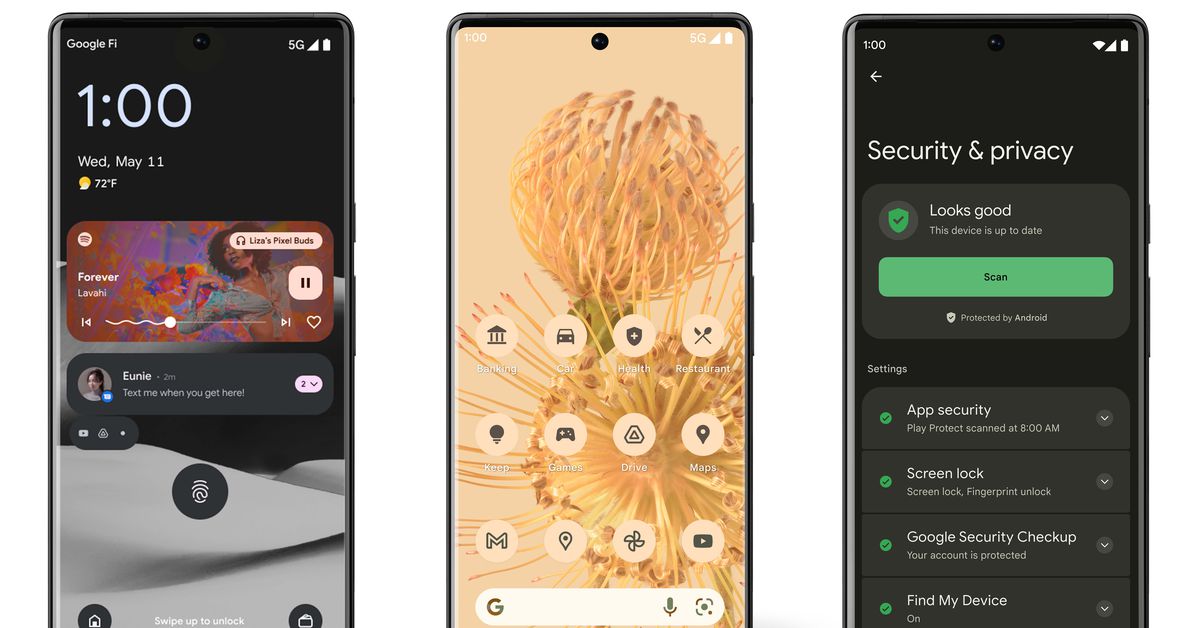Google has outlined its vision for this year’s major Android update, which looks set to continue many of the customization and privacy initiatives that the search giant introduced with last year’s Android 12. Its customizable Material You color schemes will now be available as preset themes and are also expanding to cover third-party apps icons and the media player. There are also new security features, including a dedicated Privacy and Security menu.
The direction isn’t likely to come as much of a surprise to anyone who’s kept up with Android 13’s early betas. But today’s announcements, made to coincide with the search giant’s annual Google I/O developer conference, see the company lay out its overarching vision for this year’s major Android update. The search giant is releasing Android 13’s second public beta today to coincide with the announcements.
After last year’s Material You customizable themes feature, Android can already match its color scheme to that of your phone’s wallpaper. This year, media controls are also receiving a similar Material You-style overhaul and will be able to extract colors from the album art of the music being played. Another new feature for those that don’t want or need their phone’s theme to exactly match their wallpaper is a series of optional preset color schemes to choose from.
:no_upscale()/cdn.vox-cdn.com/uploads/chorus_asset/file/23450518/3._Color_variants.jpg)
Material You theming options are also coming to third-party app icons, which appeared in Android 13’s first developer preview in February. “This was a bit of a missing part for us in the last release,” explains Google’s vice president of product management, Sameer Samat. “It felt like everything in the system UI got that nice Material You treatment except the icons. For us, it always felt like an unfinished business.” The new app icon-theming options will come to Pixel devices first and only work with supported apps.
Google Messages’ RCS support is also set to get a big improvement later this year with the beta launch of end-to-end encryption for group chats, a feature that is currently only available in one-to-one RCS chats in Google Messages. The search giant says the standard, which aims to be a successor to the now-ancient SMS and MMS protocols, is now available to over 500 million Google Messages users worldwide.
As we’ve seen from its betas, Android 13 is also placing more restrictions on the personal data and phone features apps can use by default. Soon, apps will have to ask for permission to even send notifications in the first place, and there’s also a new photo picker that lets you restrict the photos and videos an app can access, rather than granting permission to see your whole library. New permissions will also limit apps to accessing either “Photos & videos” or “Music & audio” files, rather than all filetypes.
A new Security and Privacy settings page is being added later this year to collect all of your critical data privacy information in one place. It’s designed to encourage Android users to address any security issues that might crop up.
:no_upscale()/cdn.vox-cdn.com/uploads/chorus_asset/file/23450508/6._App_language_settings.jpg)
Away from Android phones themselves, Google is also emphasizing the work it’s doing on interconnectivity with other devices. It plans to add fast-pairing support for the incoming Matter smart home standard this fall to make it quick and easy to use an Android phone to add supported smart home devices to your network. Support for the new power-efficient Bluetooth LE Audio standard is also on the way in Android 13.
A final feature worth mentioning: Android 13 will let users set system languages on a per-app basis, a feature that Samat says is helpful for multilingual users who rely on different languages in different situations. “If you’re using a social media app, you might use one language. But if you’re banking, you might use another language,” he explains.
After the chaotic rollout of Android 12, it’s perhaps reassuring to see that Google’s focus this year is on refining rather than revolutionizing Android. There’s no massive change of direction here, just a steady series of tweaks and improvements to Android’s existing initiatives.
